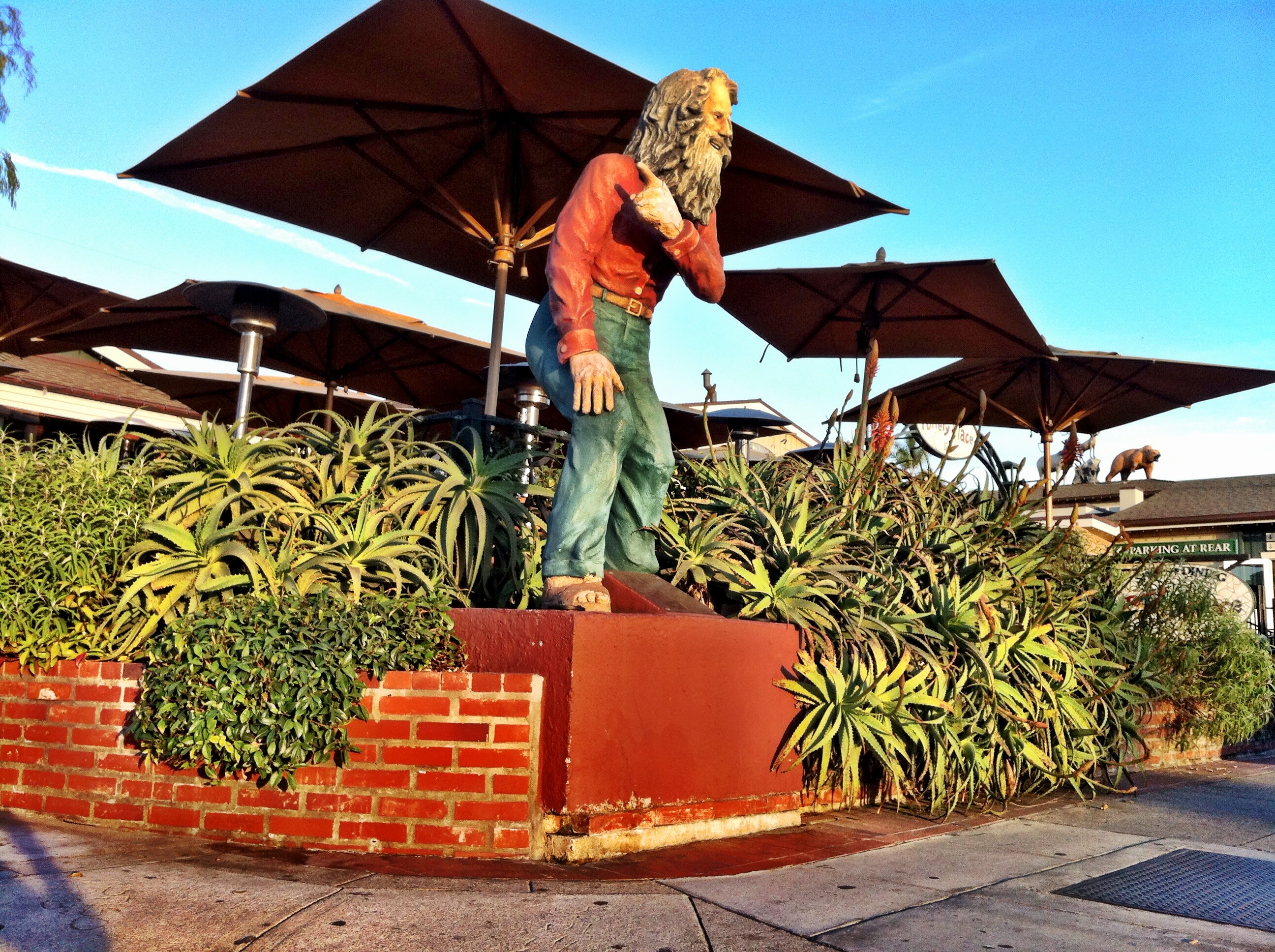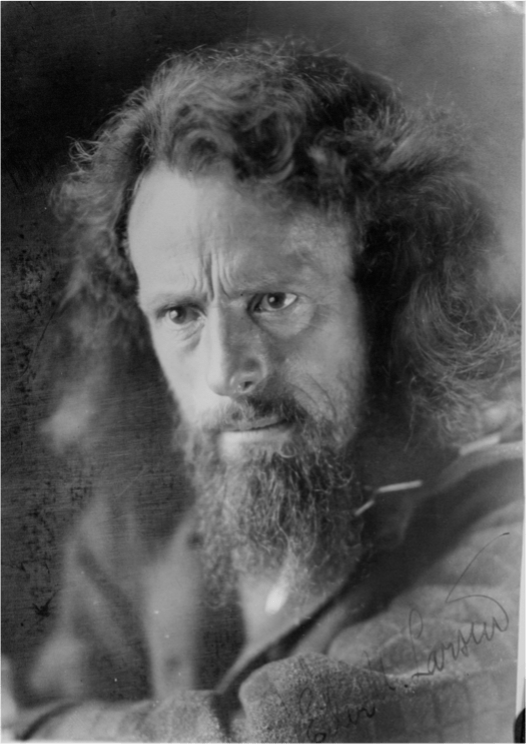By Mills Kelly and Donnelle Bonarchuk
The Apostle of Happiness
July 2, 2021
On November 13, 1930, a very tall and slightly dirty bearded man came down out of the forests on Pico Mountain and walked into Rutland, Vermont. His appearance alone must have caused passersby to stop and stare, but Eiler Larsen wouldn’t have minded. Instead, he would have stopped, raised one long arm above his head, waved, and with a huge smile on his face shouted, “Helllooooo!” so loudly that almost everyone in town would have heard him.
Larsen was an apostle of happiness who, on August 4, had set out south from Katahdin with the intention of hiking the entire Appalachian Trail (A.T.). Unlike today’s thru-hikers, so many of whom seem to be in a hurry to finish their hike right from the start, Larsen was a slow hiker who didn’t intend to hike the whole Trail in one year. Who would want to do that? In 1930, the answer was no one.
Instead, Larsen wanted to walk. He wanted to meet people. He wanted to share his joy in life and his love of nature with anyone who would listen. He gave lectures at public libraries and YMCAs.
“No human being can defeat anyone who has power and strength to stick to his ideals,” he said to his audience. “I go to the mountains to get away from the limitations of human life.”
Larsen followed an unusually twisting path to the A.T. He was born in Denmark in 1890. In his early 20s, Larsen worked as a lumber buyer for the Russian government in Siberia, but when World War I broke out he emigrated to Chile where he worked briefly as a physical education teacher. Then, in 1917, he came to the United States, where he became a citizen, volunteered for military service, fought for his adopted country in France, and was severely wounded by artillery fire.
After returning to the U.S., Larsen took a job in New York City as a legal courier, a job he loved because it kept him outside and moving, and it put him in a position to spread his love of life.
“On the street in greeting a friend I’d yell loud enough to be heard by a hundred, just to let those New Yorkers know there was somebody glad to be alive,” he told an interviewer in 1931. “Can you imagine me in Wall Street? Those poor unhappy New Yorkers! I used to carry a bunch of roses with me on my rounds of business, and whenever I saw an unhappy broker I’d hand him a rose and say, ‘Here, friend. Be happy!’”
Sometime in 1930, Larsen conceived of the idea of hiking the A.T. from Maine to Georgia and then continuing on to Key West, Florida. Before departing on his hike, this gentle giant wrote to anyone connected to the Appalachian Trail Conservancy (then the Appalachian Trail Conference) whose address he could locate to request maps, trail guides, or any other advice he could get. He found a receptive audience in the Trail community, who encouraged him to take that grand hike and to stay in touch as he walked south.
Which is how that November, Eiler Larsen found himself in downtown Rutland shouting “Helllloooo!” at anyone who might listen.
It took Larsen eight years to complete his section hike of the A.T., but complete it he did, a fact that has not been recognized in the semi-official list of end-to-end hikers maintained by the ATC or other trail organizations. But in the late 1930s, local newspapers began reporting that Larsen had, indeed, hiked all of the Trail that existed at the time.
In 1931, Larsen arrived in Washington, D.C., where he met with leaders of the ATC and Potomac Appalachian Trail Club (PATC) at their Washington headquarters, and where he sat for the below photograph. While in Washington, he spread his bedroll in the passage under Dupont Circle where he reported communing with rats, leaky ceilings, and the occasional real hobo.
In 1932, he took time out from his travels to head north again, speaking about his hikes at the bi-annual meeting of the ATC in Sherborne, Vermont, before returning to the Trail and hiking from Harrisburg, Pennsylvania, to Harpers Ferry, West Virginia.
“In the mountains, I listen to people, I try to use the mountains for spiritual inspiration and power,” Larsen told an interviewer that year.
It took him six more years to reach Georgia, partly because he regularly stopped to work, give public lectures at the Trail, and just spread the joy he felt in life. Wherever he spoke, he emphasized the importance of happiness that can be found in nature. “The beauty in nature is inexhaustible,” was one of his favorite lines.
Like many modern thru-hikers, Larsen understood that his appearance might be against him.
“Most people below the Potomac are afraid of any man with long hair and a beard,” he told the Knoxville newspaper in 1938. “But a little boy once observed I looked like ‘God coming out of the mountains.’”
Hiking during the worst years of the Great Depression, Larsen met many people desperate for any form of happiness, which helps to explain why so many came to hear him speak at the YMCA, the local Trail club, or just on a downtown street corner. One of Larsen’s favorite slogans was, “Freedom comes from within, and happiness is free!” and this giant of a man with a thick Danish accent managed somehow to pass along his pure and seemingly inexhaustible joy for life to everyone he met.
After finishing the Trail at Mount Oglethorpe in 1938 — then the southern terminus of the A.T. — Larsen continued south, hiking on to Florida before heading west to Laguna Beach, California. Along the Trail, Larsen was a local curiosity, but along the Laguna Beach boardwalk he became much better known as the unofficial, and later official, “Greeter of Laguna Beach.” Just as he had in small towns and big cities along the East Coast, Larsen stood on corners in Laguna Beach shouting out his trademark, “Hellloooo!” to passersby. He continued to lecture about the joy and peace found in nature, and he continued to astound people with his lust for life and shaggy appearance.
If you go to Laguna Beach today, you will be greeted by a life-sized statue of Larsen along the boardwalk with a plaque that reads, “Helllloooo! How Are You!!” Larsen certainly would be happy to know that even his statue still makes people smile.

“Statue of Eiler Larsen stands on the Pacific Coast Highway in Laguna Beach” by CactusWriter is licensed under CC BY-SA 3.0.
Mills Kelly
 Mills Kelly is a professor of history at George Mason University in Fairfax, Virginia. He is currently writing a history of the Trail and has just completed a shorter book titled Virginia’s Lost Appalachian Trail, about the original route the Trail took between Roanoke and Damascus, that he hopes will be published in 2021. “I first hiked on the A.T. in the early 1970s and it seems like the Trail has been part of my life ever since,” he says.
Mills Kelly is a professor of history at George Mason University in Fairfax, Virginia. He is currently writing a history of the Trail and has just completed a shorter book titled Virginia’s Lost Appalachian Trail, about the original route the Trail took between Roanoke and Damascus, that he hopes will be published in 2021. “I first hiked on the A.T. in the early 1970s and it seems like the Trail has been part of my life ever since,” he says.
Donnelle Bodnarchuk
 Donnelle Bodnarchuk is a recent graduate from George Mason University where she studied History and Art History. She is currently enrolled at the Maurice A. Deane School of Law at Hofstra University in Long Island, New York. While at George Mason she studied under Dr. Kelly, finding a passion and interest in local history which she used to research into the Appalachian Trail.
Donnelle Bodnarchuk is a recent graduate from George Mason University where she studied History and Art History. She is currently enrolled at the Maurice A. Deane School of Law at Hofstra University in Long Island, New York. While at George Mason she studied under Dr. Kelly, finding a passion and interest in local history which she used to research into the Appalachian Trail.


